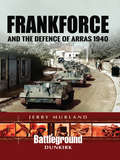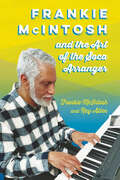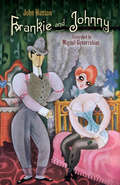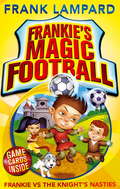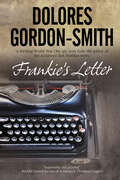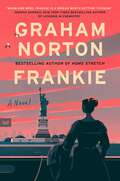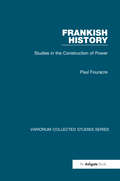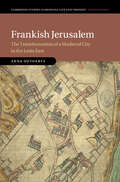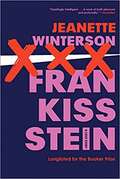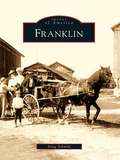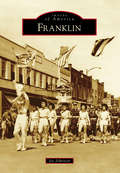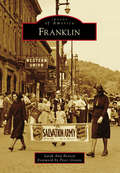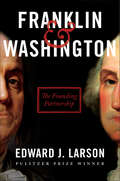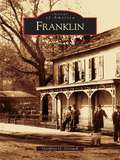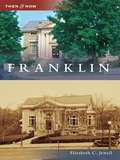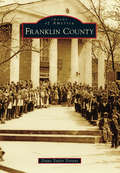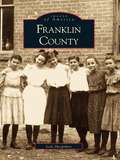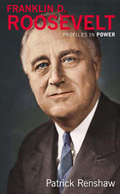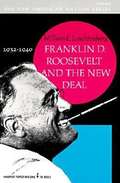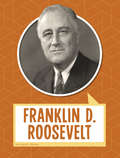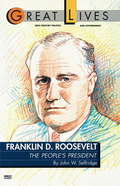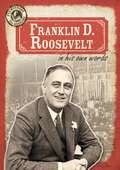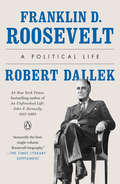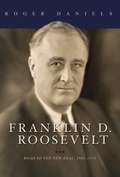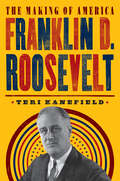- Table View
- List View
Frankforce and the Defence of Arras 1940 (Battleground Dunkirk)
by Jerry MurlandThere is no other city in France that has the same associations in time of conflict that the British have with Arras. Since the campaigns of John Churchill, 1st Duke of Marlborough, in the early 18th century, British soldiers have fought in and around Arras, occasionally as an enemy but, more often, as defenders of French and Allied democracy. Battlefield visitors to the area will immediately recognize the names of towns and villages that were as significant to the men of Marlboroughs army as they were to those who fought in the First and Second World Wars.This book serves both as guide to the Second World War battlefields that surround the city and its environs as well as detailing the actions of the British armored attack of 21 May 1940. The book looks at the strategic situation that led up to the famous Arras counterstroke and, using material that has not been published before, examines the British and German actions between 20 and 23 May. The only Victoria Cross action that took place during this time is looked at in detail; as is the fighting that took place in Arras and during the breakout.Despite its shortcomings, the counterstroke achieved the essential element of surprise and caused widespread alarm amongst the German command and hit Rommels 7th Panzer Division at precisely the moment when his armored units were ahead of the infantry and gunners. The British infantry fought well and both the Durham battalions were fortunate that their commanding officers and senior NCOs were men who had already fought in one conflict and possessed the determination to rally their less experienced junior ranks and fight on regardless. Such was the case with the two tank battalions, although sadly they lost both their commanding officers and over half the tanks that went into the engagement. The attack did enable the British to tighten their hold on Arras albeit temporarily and, as is often cited, built doubts in the minds of German High Command as to the speed of their advance and contributed to the subsequent Hitler halt order of 24-27 May.The author has gone to some lengths to track down accounts from those individuals who served in the area during May 1940 and fought the enveloping tide of the German advanceThe book is supported by three car tours, one of which takes the visitor along the tragic path taken by the Tyneside Scottish on 20 May and two walking routes, which concentrate on Arras.137 black and white photographs (integrated) and a number of maps derived from regimental histories; and six tour maps provide the battlefield visitor with illustrations of the battlefields as they were in 1940 and as they are today.
Frankie McIntosh and the Art of the Soca Arranger
by Ray Allen Frankie McIntoshSoca music, an offspring of older Trinidadian calypso, emerged in the late 1970s and is now recognized as one of the English-speaking Caribbean’s most distinctive styles of popular vocal music. Frankie McIntosh and the Art of the Soca Arranger tells a story of Caribbean music in the diaspora through the eyes and ears of a pioneering soca arranger. A fascinating collaboration between Frankie McIntosh and music scholar Ray Allen, this cowritten memoir places the music arranger at the center of several overlapping narratives of immigration and musical diaspora.The book begins with McIntosh’s personal voyage from Saint Vincent to Brooklyn and his efforts to hammer out a career in music while raising a family in his newly adopted home. His immigrant tale is intertwined with his musical journey, from popular Caribbean dance bands through formal studies in Western classical music and jazz to his work as a gigging jazz pianist and calypso/soca arranger. Along the way he embraced the varied musics of New York’s African American and West Indian communities, working with such iconic calypsonians as the Mighty Sparrow, Lord Kitchener, Calypso Rose, and Alston “Becket” Cyrus. His story provides a unique lens for viewing Brooklyn Carnival music and brings into focus the borough’s rise to prominence as the transnational hub of the soca music industry in the 1980s.An alternative to traditional scholarship that tends to focus on calypso and soca singers, this work explores the instrumental dimensions of the art form through the life and music of one of the most celebrated soca arrangers and keyboardists of all time.
Frankie and Johnny
by John Huston Miguel CovarrubiasThe ill-fated lovers Frankie and Johnny were already legends by 1930, the year of this illustrated drama's publication. The unique interpretation is a collaboration between John Huston, the future director of The Maltese Falcon and other film classics, and Miguel Covarrubias, an influential painter and caricaturist. Huston, who reputedly interviewed a neighbor of the real-life Frankie and Johnny, was inspired to adapt the tale of love gone wrong for a puppet show for which George Gershwin supplied musical accompaniment. In addition to Huston's script and distinctive images by Covarrubias, this edition features the "Saint Louis Version" of the folktale, regarded as the most authentic version, as well as 20 variations on the story and song.
Frankie vs The Knight's Nasties: Book 5 (Frankie's Magic Football #5)
by Frank LampardFrankie and his team love playing football. There's always time for a game. And now that they have their magic football they're playing against teams they never imagined!So when Frankie, Louise, Charlie and trusty Max get sent back to medieval times they're going to have to beat the nastiest knights to get home.
Frankie's Letter
by Dolores Gordon-SmithThis WWI spy thriller &“packed with adventure, action, and unforeseen twists&” by the author of the Jack Haldean mysteries &“will appeal to Ken Follett fans&” (Booklist). It&’s 1915, and Dr. Anthony Brooke has been called away from his medical practice to spy for the British Crown. But now it seems his mission has been compromised. In a hotel in Kiel, Germany, a colleague&’s dying words are, &“There&’s a spy in England . . . Frankie&’s letter. Read Frankie&’s letter . . .&” But Anthony hasn&’t a clue who Frankie might be. With his cover blown and the German army at his heels, Anthony&’s search for the truth leads him to a seemingly innocent estate in the English countryside. Here, in the home of a British publishing magnate and his beautiful French wife, Anthony uncovers a web of spies, treachery, and terrorists as the war gets closer—and becomes all too personal. &“[An] exciting spy thriller full of period charm.&” —Kirkus Reviews &“Dolores Gordon-Smith keeps her plot twisting and turning.&” —Historical Novel Society
Frankie: A Novel
by Graham Norton"Warm and wise, Frankie is a woman worth getting to know."—Bonnie Garmus, New York Times-bestselling author of Lessons in ChemistryFrom the internationally bestselling author and host of The Graham Norton Show, a dazzling and decades-sweeping story about love, bravery, and what it means to live a significant life.Always on the periphery, looking on, young Frankie Howe was never quite sure enough of herself to take center stage—after all, life had already judged her harshly. Now old, Frankie finds it easier to forget the life that came before.Then Damian, a young Irish caretaker, arrives at her London flat, there to keep an eye on her as she recovers from a fall. A memory is sparked, and the past crackles into life as Damian listens to the story Frankie has kept stored away all these years.Traveling from post-war Ireland to 1960s New York—a city full of art, larger-than-life characters and turmoil—Frankie shares a world in which friendship and chance encounters collide. A place where, for a while, life blazes with an intensity that can’t last but will perhaps live on in other ways and in other people.
Frankish History: Studies in the Construction of Power (Variorum Collected Studies)
by Paul FouracreThe volume consists of sixteen papers on the history of Francia between the seventh and eleventh centuries. Originally published between 1979 and 2009, the papers are arranged around three interlinking themes: the relationship between History and Hagiography, the history of Francia under the respective regimes of the Merovingan and Carolingian kings, and the problem of how states with weak governing institutions were able to exercise power over large areas. The history of Francia has been one of the most productive areas of early medieval history over the past two generations. Models of European development have been based on its rich materials and the fact that the polity lasted for half a millennium makes it a prime area for the study of the dialectic between continuity and change. The papers collected here all have this ’big history’ as their background. It is to be hoped that keying into such questions makes them both accessible and useful for students and teachers alike.
Frankish Jerusalem: The Transformation of a Medieval City in the Latin East (Cambridge Studies in Medieval Life and Thought: Fourth Series)
by Anna GutgartsFocusing on Jerusalem under Frankish rule following the Crusader conquest of 1099, this book sheds light on the dynamic socio-economic factors that shaped Jerusalem's gradual urban transformation. In exploring the extensive corpus of medieval property records, it reveals that the growth of Jerusalem's monumental and symbolic landscape, as befitted its new status as the capital of the Latin Kingdom, was in tandem with more mundane facets of life in the city, such as growing residential settlement patterns, and the expansion of its rural hinterland. This places the history of Frankish Jerusalem in a broader theoretical framework by analyzing the socio-economic and institutional mechanisms – such as immigration and the formation of medieval trust – that shaped the cityscape during a particularly tumultuous period in its history, and places it against the backdrop of medieval urbanisation processes in other regions.
Frankissstein: A Love Story
by Jeanette WintersonSince her astonishing debut at twenty-five with Oranges Are Not the Only Fruit, Jeanette Winterson has achieved worldwide critical and commercial success as “one of the most daring and inventive writers of our time” (Elle). Her new novel, Frankissstein, is an audacious love story that weaves together disparate lives into an exploration of transhumanism, artificial intelligence, and queer love. <p><p> Lake Geneva, 1816. Nineteen-year-old Mary Shelley is inspired to write a story about a scientist who creates a new life-form. In Brexit Britain, a young transgender doctor called Ry is falling in love with Victor Stein, a celebrated professor leading the public debate around AI and carrying out some experiments of his own in a vast underground network of tunnels. Meanwhile, Ron Lord, just divorced and living with his mom again, is set to make his fortune launching a new generation of sex dolls for lonely men everywhere. Across the Atlantic, in Phoenix, Arizona, a cryogenics facility houses dozens of bodies of men and women who are medically and legally dead… but waiting to return to life. <p> What will happen when homo sapiens is no longer the smartest being on the planet? In fiercely intelligent prose, Jeanette Winterson shows us how much closer we are to that future than we realize. Funny and furious, bold and clear-sighted, Frankissstein is a love story about life itself.
Franklin
by Doug SchmidtFranklin is a microcosm of how a sparsely populated farming community may progress into a small city. German and Irish settlers established Franklin's earliest business enterprises--taverns, blacksmiths, farm supply stores, and the annual Labor Day fair, which remains the largest of its kind in Milwaukee County. In 1956, Franklin moved from a township to a city, featuring a single patrolman and an all-volunteer fire department. For entertainment, Franklinites availed themselves of the 41 Twin Outdoor Theater or Saturday night races at Hales Corner Speedway, Little League diamonds in St. Martins or behind the fire station, and dance halls at Heiden's or the White Dove. A new era began when Franklin High School opened its doors to 350 students in 1962. Today, at 36 square miles--Milwaukee's largest suburb--it is noteworthy that Franklin still has room for a functioning stone quarry and the Tuckaway Country Club.
Franklin
by Joe JohnstonStudents of the Civil War know Franklin, Tennessee, for the major battle that happened here, but there is a lot more to the story. In fact, Main Street in Franklin is a glimpse into 250 years of history. Within a few blocks surrounding the public square, some of the city's original buildings now house the newest and most popular shops, restaurants, and entertainment venues in Middle Tennessee. Franklin has been a center for agriculture and manufacturing. It is a place where families can enjoy small-town life on the interstate. It is home to a college. It has always been the seat of Williamson County. Franklin's small businesses have a habit of sticking around for decades, often passing through generations of the same family. Franklin is as quaint and picturesque as it is exciting and progressive, because it continues to attract the kind of people who have always made it that way.
Franklin
by Peter Greene Sarah Ann BentonOn December 4, 1753, Gen. George Washington traveled to the junction of the Allegheny River and French Creek during one of his military excursions. There, the settlement was called Venango but soon became known as Franklin. Established in the heart of the original oil country in the 1740s, Franklin is the seat of Venango County. Once referred to as "the Nursery of Great Men," it boasts a rich history of industry and railroads. Franklin's historic district, listed in the National Register of Historic Places, includes businesses that have been staples in the city for over 100 years, such as Feldman Jewelers and Anderson Furniture. Today, Franklin takes great pride in its history and heritage. Franklin's annual Applefest, the largest craft festival in western Pennsylvania, honors the travels of Johnny Appleseed, who planted his trees throughout the town during his journeys, and the bridge that spans the confluence of the Allegheny and French Creek is still known as Washington Crossing.
Franklin & Washington: The Founding Partnership
by Edward J. Larson"Larson's elegantly written dual biography reveals that the partnership of Franklin and Washington was indispensable to the success of the Revolution." —Gordon S. Wood From the Pulitzer Prize-winning historian comes a masterful, first-of-its-kind dual biography of Benjamin Franklin and George Washington, illuminating their partnership's enduring importance. NATIONAL BESTSELLER • One of Washington Post's "10 Books to Read in February" • One of USA Today’s “Must-Read Books" of Winter 2020 • One of Publishers Weekly's "Top Ten" Spring 2020 Memoirs/BiographiesTheirs was a three-decade-long bond that, more than any other pairing, would forge the United States. Vastly different men, Benjamin Franklin—an abolitionist freethinker from the urban north—and George Washington—a slaveholding general from the agrarian south—were the indispensable authors of American independence and the two key partners in the attempt to craft a more perfect union at the Constitutional Convention, held in Franklin’s Philadelphia and presided over by Washington. And yet their teamwork has been little remarked upon in the centuries since.Illuminating Franklin and Washington’s relationship with striking new detail and energy, Pulitzer Prize–winning historian Edward J. Larson shows that theirs was truly an intimate working friendship that amplified the talents of each for collective advancement of the American project.After long supporting British rule, both Franklin and Washington became key early proponents of independence. Their friendship gained historical significance during the American Revolution, when Franklin led America’s diplomatic mission in Europe (securing money and an alliance with France) and Washington commanded the Continental Army. Victory required both of these efforts to succeed, and success, in turn, required their mutual coordination and cooperation. In the 1780s, the two sought to strengthen the union, leading to the framing and ratification of the Constitution, the founding document that bears their stamp.Franklin and Washington—the two most revered figures in the early republic—staked their lives and fortunes on the American experiment in liberty and were committed to its preservation. Today the United States is the world’s great superpower, and yet we also wrestle with the government Franklin and Washington created more than two centuries ago—the power of the executive branch, the principle of checks and balances, the electoral college—as well as the wounds of their compromise over slavery. Now, as the founding institutions appear under new stress, it is time to understand their origins through the fresh lens of Larson’s Franklin & Washington, a major addition to the literature of the founding era.
Franklin (Images of America)
by Geoffrey G. GorsuchFranklin was first established in 1796 as a sleepy collection of cabins along the beautiful Great Miami River. When the Miami Canal came through the village in 1829, and the railroad followed in the 1870s, many new industries came to the area, and the downtown filled with fine brick and stone residences, businesses, churches, and public buildings. The town prospered through the 19th century, and the proud community's leaders proclaimed a grand celebration of its past, present, and envisioned future: the FranklinHomecoming of 1910. Just three years later, Franklin was struck by the greatest calamity in its history, the Flood of 1913. Though Franklin quickly recovered, it soon left its past behind, as it became a modern city in a rapidly changing nation. Through vintage images of buildings, businesses, and people now gone and forgotten, Franklin brings to life the town's rich history, from its beginnings to 1920.
Franklin (Then and Now)
by Elizabeth C. JewellFranklin, incorporated in 1895, is New Hampshire's smallest city and is situated where the Pemigewasset and Winnipesaukee Rivers form the headwaters of the Merrimack River. Long known as the "Gateway to the White Mountains," Franklin was once a thriving tourist destination and a bustling mill town. These deep and varied roots inspired resident Elizabeth C. Jewell to document the city's development. Franklin continues to look towards the future and remains respectful of its past.
Franklin County
by Diane Taylor TorrentFranklin County is situated in the northeastern Piedmont region of North Carolina. Known for its fruitful soil, rolling hills, and bountiful streams, it has a rich agricultural heritage. Franklin County was created in 1779, with its founders honoring statesman Benjamin Franklin as the county's namesake. Built along the Tar River, Louisburg, the county seat, has an impressive historic district lined with majestic homes and churches from the turn of the 20th century. Steeped in education, Franklin County is home to Louisburg College, which was established in 1787, and once boasted as many as 100 one-room schoolhouses. Franklin County showcases the architectural heritage, long-standing communities, and citizens who have lived and worked here.
Franklin County
by Lola ShropshireCreated from a portion of Crawford County in 1837, Franklin County is divided by the Arkansas River into two sections, each with its own county seat: Ozark in the North and Charleston in the South. Northern Franklin County is remote, mysterious, and beautiful, while the southern area enjoys graceful and vastly productive prairie lands. The combination of fertile soil and mild climate in the Ozark Mountains produces fruit, vineyards, precious stones, granite, and forests. Evocative images such as the young girls posing in the Altus schoolyard paint a poignant and revealing picture of everyday life in Franklin County. Coal mining played a large part in the lives of residents, and photographs of soot-covered miners display the hardships of this difficult work. With over two hundred photographs gathered from local collections, this book illustrates the history and culture of Franklin County in vivid detail, with captions that are both entertaining and informative.
Franklin D Roosevelt (Profiles In Power)
by Patrick RenshawAn important addition to the Profiles in Power series, this critical biography looks at Franklin D. Roosevelt, the most dominant US politician of the 1930s and 1940s. Roosevelt led the United States through the two great crises of depression and the Second World War, making him one of the key figures of the twentieth century.
Franklin D Roosevelt and the New Deal 1932 -1940
by William E. LeuchtenburgWhen the stability of American life was threatened by the Great Depression, the decisive and visionary policy contained in FDR's New Deal offered America a way forward. In this groundbreaking work, William E. Leuchtenburg traces the evolution of what was both the most controversial and effective socioeconomic initiative ever undertaken in the United States -- "and explains how the social fabric of American life was forever altered. It offers illuminating lessons on the challenges of economic transformation -- "for our time and for all time.
Franklin D. Roosevelt (Biographies)
by Laura K. MurrayHow much do you know about Franklin Roosevelt? Find out the facts you need to know about the 32nd president of the United States. You'll learn about the early life, challenges, and major accomplishments of this important American.
Franklin D. Roosevelt (Great Lives Series): The People's President (Great Lives Series)
by John W. SelfridgeWitness history in the making as you turn the pages of time and discover the fascinating lives of famous explorers, leaders of twentieth-century politics and government, and great Americans. &“The only thing we have to fear is fear itself.&” With these resounding words and innovative, often controversial, programs Franklin D. Roosevelt stirred a nation to confront and triumph over the Great Depression of the 1930s, the gravest domestic crisis since the Civil War. Roosevelt then led the U.S. to victory over twin menaces from abroad—Nazi Germany and Japan—in World War II. It was a dazzling display of sustained, imaginative leadership that changed the presidency, and the country, forever. Franklin D. Roosevelt: The People&’s President depicts the life and times of one of America&’s best-loved presidents. Roosevelt paid little heed to his personal adversity—the polio that crippled his legs. Listen to his radio addresses—the famed &“fireside chats&”—and see how he showed the American people just how much a president can do.
Franklin D. Roosevelt in His Own Words
by John SheaFranklin D. Roosevelt was one of the most powerful and popular US presidents. He was the only one to serve 12 years and was elected four times. As the leader of the nation, he saw the country through an economic depression and World War II. Through primary sources, personal and political writings, and quotations, readers will become familiar with the man behind the famous name, from his early life to his momentous presidency. This book is a unique way to examine US history in the early twentieth century through the biography of one remarkable man.
Franklin D. Roosevelt: A Political Life
by Robert Dallek“In a period defined by division, gridlock and tweet storms, Dallek crafts a pointillist portrait of the four-term president” —Peter M. Gianotti, Newsday“Will rank among the standard biographies of its subject” —Publishers WeeklyA one-volume biography of Roosevelt by the #1 New York Times bestselling biographer of JFK, focusing on his career as an incomparable politician, uniter, and deal maker In an era of such great national divisiveness, there could be no more timely biography of one of our greatest presidents than one that focuses on his unparalleled political ability as a uniter and consensus maker. Robert Dallek’s Franklin D. Roosevelt: A Political Life takes a fresh look at the many compelling questions that have attracted all his biographers: how did a man who came from so privileged a background become the greatest presidential champion of the country’s needy? How did someone who never won recognition for his intellect foster revolutionary changes in the country’s economic and social institutions? How did Roosevelt work such a profound change in the country’s foreign relations? For FDR, politics was a far more interesting and fulfilling pursuit than the management of family fortunes or the indulgence of personal pleasure, and by the time he became president, he had commanded the love and affection of millions of people. While all Roosevelt’s biographers agree that the onset of polio at the age of thirty-nine endowed him with a much greater sense of humanity, Dallek sees the affliction as an insufficient explanation for his transformation into a masterful politician who would win an unprecedented four presidential terms, initiate landmark reforms that changed the American industrial system, and transform an isolationist country into an international superpower. Dallek attributes FDR’s success to two remarkable political insights. First, unlike any other president, he understood that effectiveness in the American political system depended on building a national consensus and commanding stable long-term popular support. Second, he made the presidency the central, most influential institution in modern America’s political system. In addressing the country’s international and domestic problems, Roosevelt recognized the vital importance of remaining closely attentive to the full range of public sentiment around policy-making decisions—perhaps FDR’s most enduring lesson in effective leadership.
Franklin D. Roosevelt: Road to the New Deal, 1882-1939
by Roger DanielsFranklin D. Roosevelt, consensus choice as one of three great presidents, led the American people through the two major crises of modern times. The first volume of an epic two-part biography, Franklin D. Roosevelt: Road to the New Deal, 1882-1939 presents FDR from a privileged Hyde Park childhood through his leadership in the Great Depression to the ominous buildup to global war. Roger Daniels revisits the sources and closely examines Roosevelt's own words and deeds to create a twenty-first century analysis of how Roosevelt forged the modern presidency. Daniels's close analysis yields new insights into the expansion of Roosevelt's economic views; FDR's steady mastery of the complexities of federal administrative practices and possibilities; the ways the press and presidential handlers treated questions surrounding his health; and his genius for channeling the lessons learned from an unprecedented collection of scholars and experts into bold political action. Revelatory and nuanced, Franklin D. Roosevelt: Road to the New Deal, 1882-1939 reappraises the rise of a political titan and his impact on the country he remade.
Franklin D. Roosevelt: The Making Of America #5 (The Making of America)
by Teri KanefieldThis biography for young readers explores the life of the thirty-second president, who lifted the United States from depression to global leadership.When Franklin D. Roosevelt was first elected president in 1933, America was in the throes of the Great Depression—the worst economic crisis in U.S. history—and the world was experiencing a menacing rise in Nazism and other dangerous extremists. Throughout his four presidential terms, Roosevelt was a steady and inspiring leader. He implemented progressive social reform through his New Deal agenda and helped lift America from economic crisis. He guided America to victory in World War II. Born into wealth and privilege, Roosevelt entered politics at a young age. His career and world views were shaped by his marriage to Eleanor Roosevelt and his long struggle with polio. Franklin Delano Roosevelt, our thirty-second president, forever left his mark on our nation and the world. By the time of his death, America had grown to a global economic and military superpower. His New Deal legislation changed the relationship of American citizens to their government. His policies came close to fully realizing Alexander Hamilton’s vision of a government that touches and improves the lives of all citizens.The book includes selections from Roosevelt’s writings, endnotes, a bibliography, and an index.“Kanefield provides readers with an intimate examination of Franklin Delano Roosevelt. . . . It flows in a friendly and welcoming style that reluctant readers will appreciate. . . . A solid account for both history buffs and report-writers.” —Kirkus Reviews“Neither hagiography nor a hatchet job, this evenhanded overview of FDR walks a middle path perfect for middle grade readers. A commendable addition to school and public library collections.” —School Library Journal
